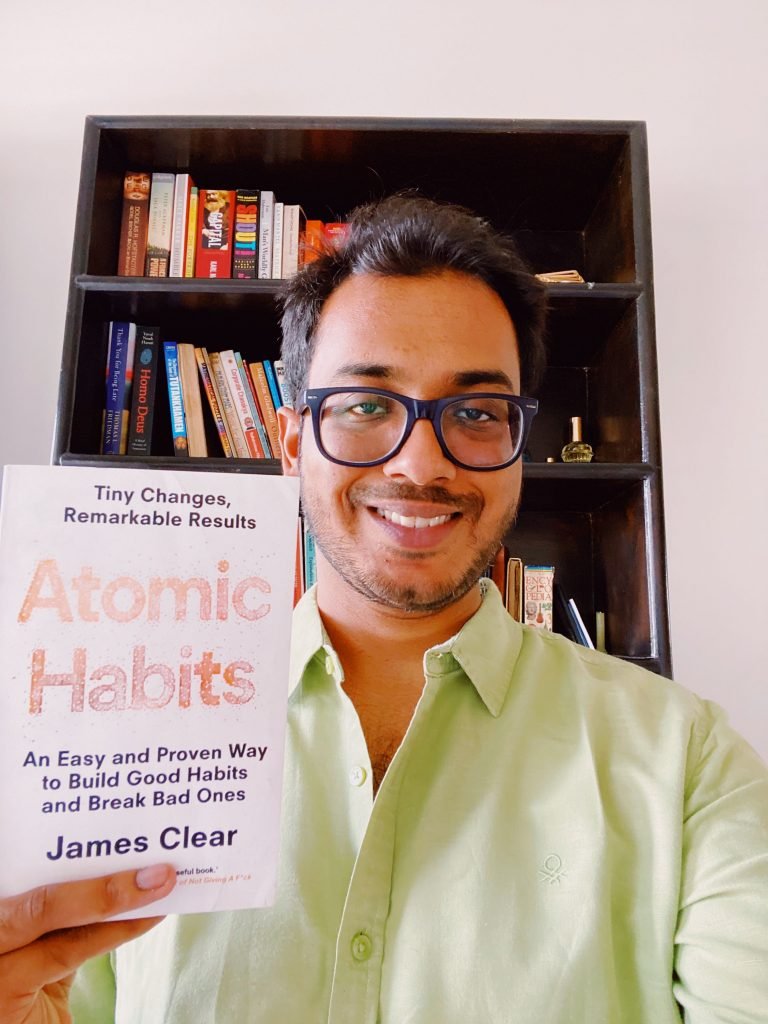We read Atomic Habits by James Clear as part of the Wingify Book Club pick for February, 2021. These are notes from the book from Ishan Goel.
Motivation and Introduction
Atomic Habits is a wonderful book that we read as part of the Wingify Book Club for the month of February in 2021. The book has given me clarity on a core aspect of my life. For most part of my professional life, I have been a burst worker and not a regular worker. Somewhere deep down I used to appreciate the burst part of burst workings because it used to give me assurance that I can put in a night and get a significant amount of work done. However, there is a fundamental problem with burst working, burst modes are activated by only one of the two forms of motivation; either passion, or compulsion. When either of them run dry burst modes seem practically intractable. In the uncertainty of these burst mode activations, smaller projects are achievable and you get them through, but larger projects just become very susceptible to getting stuck due to the lack of motivation at some point of time. Further, this uncertainty of burst mode activation makes it difficult to collaborate since in the absence of motivation it gets harder and harder to stay in a coordinated schedule with a team. In summary, to scale up the value you create as an individual and collectively in a team, burst mode is just very uncertain to rely on. Deadlines go unmet, goals remain unfulfilled and dreams continue to be unrealised.

The book exposed me to a fundamentally better model of work that has probably always been in common knowledge because the importance of habits have long been advocated by our elders. However, the book articulated the concepts in a way that it struck a chord with me and I got to realising that I will have to radically part ways with the burst mode of getting things done. The central pinnacle of the realisation was the following statement:
“You don’t rise to the level of your goals, you fall to the level of your systems”
Regular habits help you form an automated framework in your life that gets work done without putting constant mental effort into doing each thing. A simple example that struck me was that for me and most of my peers in our generation the simple act of going to sleep requires mental effort everyday. Yes, that is true. Going to sleep requires an everyday mental effort because you need to decide that all work for the day has been done and I don’t want to do anything else while delaying the task of sleeping. This mental effort of deciding to sleep translates into an everyday mental and physical effort to wake up when I need to actively tell my body that I cannot afford to sleep any longer. In an automated framework, you would sleep without thinking about it and wake up without requiring your body to wake up.
I realised that this sort of an automated framework doesn’t stop when motivations run dry, it keeps on going because of your brain’s inertia to the habits it has. It is the key framework that will make reaching deadlines, goals and dreams more certain in your life and more effortless. This realisation has helped me a great deal in changing my perspective towards doing things daily and building a solid framework of habits in my life. Below I start with a summary of the core concepts of the book and then moving on to create a structure for implementing three good habits and eradicating one bad habit by using the techniques explained in the book.
Nonetheless, I deeply thank Wingify for motivating me to read this book and I would like to repay the favour to the Wingify community by implementing a few of these techniques in my life and always being open to discuss my approach with anyone who needs motivation and guidance to kickstart this approach.
Summary of the concept
The book explains that any habit can basically be broken down into four key components:
- Cue: The cue is the trigger that kicks off the automatic process in the brain. The cue can be anything ranging from a time, a place or something that you do.
- Craving: Whenever a cue associated to a habit takes place, your brain automatically starts to generate a craving for the habit.
- Response: The response is the actual habit that you perform to satisfy the craving.
- Reward: Reward is the dopamine release that you get by performing the habit.
The idea that the book explains is that making or breaking any habit is associated with making the steps above easier or harder. The entire book is divided into sections for each of the four components and discusses various ways to work upon the particular component to either make or break the habit.
The following table turns each component into an actionable corresponding to a good habit that you want to make or a bad habit that you want to break.
| Component | Good Habits | Bad Habits |
| Cue | Make it obvious | Make it invisible |
| Craving | Make it attractive | Make it unattractive |
| Response | Make it easy | Make it difficult |
| Reward | Make it satisfying | Make it unsatisfying |
Now let us go over the different techniques that the book explains that you can use to implement the above actionables.
Techniques for building Good Habits
There are four actionables that you can do to start creating a good habit in your life. It is not crucial that you deploy all techniques and not all techniques suit the format of every habit as well. The idea is to deploy a technique wherever it fits and let it act as a catalyst in habit formation.
- Make it obvious: The idea of this step is to make the cue more and more obvious for any good habit so that the habit becomes repeatable. There are the following ways to do it:
- Time and place binding: The idea is to define a time and place where you will do that habit. Pick up a time and place combination that happens often in your life and bind the habit to it.
- Habit stacking: The idea here is to make a new habit by stacking it up with a previously existing habit. For instance, flossing after brushing your teeth is a classic habit stacking technique.
- Environment Design: You can actively design your environment to add cues for certain habits that you want to create. Alternatively you can also flip this method. You can remove cues from the environment if they relate to bad habits for you.
- Make it attractive: The idea of this step is to make any habit more attractive so that the craving becomes more natural and regular.
- Temptation Bundling: The idea in this part is similar to Habit Stacking but slightly different. The crux is to bundle a habit that you like to do with a habit that you have to do. For instance, one idea can be that if you like to have coffee from a coffee place in the evening, then make the habit of walking up to the coffee place.
- Social Validation: The idea here is that get closer to people where the desired habit is normal behavior. Social validation acts as a great way to make a habit attractive.
- Habit Rituals: The crux of the idea is that create cues of your choice to habits that you need to do. For instance, with constant effort you can listen to a particular song everyday before workout. Later, you can use this song to automatically generate a temptation for the habit.
- Make it easy: This is a crucial thing. Habits that are easy to do become easier to follow and easier to maintain as well.
- Decreasing friction: The idea here is reduce the steps required in performing a good habit or preparing for performing a good habit. The idea is that if it is easier to do then you will do it even on the lowest motivation days.
- Master decisive points: This is an interesting idea. The decisive moment which leads you to not performing a good habit often happens much before and often seems much more insignificant than it is. For instance, going to the gym in the morning is often not tied to waking up early, it might be tied down to not going out with friends last night. Sit down and trace back these decisive moments, make a conscious note of them so that you always take the right decision in these moments.
- Two minute rule: Scale down habits that require a larger effort into something that can be done in less than two minutes to first kickstart the regularity. Gradually you can expand them into full-blown activities.
- Automate your habits: Invest in technology if it helps a good habit. For instance, a financial app that does the sum and subtract for you is better than noting down expenses in a notebook.
- Make it satisfying: The above three categories of techniques will help you perform the habit this time. However, the fourth category motivates you to perform the habit next time.
- Reinforcements: The idea here is to give yourself a reward after completing the habit so that you associate the habit with the reward.
- Habit Tracker: A habit tracker is a daily calendar on which you mark an X everytime you complete that habit. Habit Tracking practically covers three aspects simultaneously – It makes it obvious, makes it attractive and makes it satisfying. However, you need to be very careful with what not to track as habit tracking can sometimes backfire. For instance, if you want to lose weight, daily weight tracking will severely reduce your motivation since weight doesn’t reduce everyday.
- Accountability Partner: Have someone do this habit with you or make a contract with someone who you are accountable to or set up a commitment that what will you do in case you fail to do the habit.
Techniques for eliminating Bad Habits
Habits are like a double edged sword. They can work for you but also work against you. Hence, the same principle apply to cutting out bad habits and in this section we will discuss some techniques to cut out a bad habit that you might have. Apart from these, some methods in the above section can be inverted to utilize them to cut out a bad habit.
- Make it invisible: The idea here is just the opposite. Make the cues invisible as much as you can to avoid the habit.
- Habit Charting: Start by becoming aware of all your bad habits so that you can cut each of them out consciously and systematically.
- Environment Design: Identify and remove cues from the environment that lead you to do the bad habits. For instance, a lighter on your desk might be the cue for smoking. Remove the lighter from the desk.
- Make it unattractive: Bad habits are often desirable because they are attractive due to their first order benefits. The second and third order benefits are often bad.
- Highlight the negatives: Prime yourself to focus on the second and third order benefits of the habit so that you associate the habit with those consequences rather than the first order satisfactions.
- Social invalidation: Social Invalidation works great in making things unattractive. Disclose your bad habits to people closest to you. It will automatically make them unattractive.
- Make it difficult: Make a bad habit as difficult as it can be.
- Increase friction: Increase as much friction as you can in your bad habits. If ordering food is a bad habit, remove Zomato from your phone. Add as many steps as you can to doing a bad habit.
- Commitment Devices: Commitment devices are sort of the inversion of “Mastering Decisive Moments”. In moments, when you are motivated to cut out a bad habit do something that cuts out your future self from performing the bad habit. For instance, if you tend to overeat, ask the waiter to split your meal into two and pack one half beforehand.
- Make it unsatisfying: Finally, there are ways to make a bad habit unsatisfying so that you do not repeat it.
- Accountability partner: You can make yourself accountable to someone close by building a mechanism where whenever you perform a bad habit it reaches them. Even if they do not say anything to you, we are social creatures and their soft (and even quiet) invalidation will make it very unsatisfying to the other person.
- Paid contract: Tie with someone to pay them a fixed amount whenever you perform a bad habit. Money always pinches and will make sure you lose the habit as early as possible.
Implementation
In this section, I plan to use the above techniques in practice and brainstorm creative ways to apply them for specific habits. For this exercise, I am targeting four habits, three good and one bad that I plan to implement in my life as a starting step. If I am successful in implementing any three out of four of these habits, I will consider reading this book a success and will always associate those habits in my life with Wingify’s book club.
- Exercising (+): I have recently joined Cult.fit (with a friend) and find the exercise format very effective and relatively easy to do. Although I have already started to apply some techniques while reading the book I will formalise the techniques in this section. This will take at max 1 hour of my time everyday including travelling.
- Financial tracking (+): This is a habit that my father religiously followed all through his life and I feel this is the building block of financial planning. This should take hardly 10 minutes everyday if it is done everyday.
- Quick reading a research paper daily (+): Quickly reading a research paper tells you in summary what has been done in the paper and what direction of work has been explored. I feel the sort of field Data Science is I need to inculcate this habit. I will later extend this habit to weekend deep review of at least two research papers I liked and summarising them.
- Eating Unhealthy (-): I want to eliminate this habit as much as I can because this is crucial for me to be productive and healthy in the middle age of my life.
The first habit: Exercising
Below I am brainstorming systematically on the four macro steps to develop tips and tricks to enforce the habit of exercising.
- Make it obvious
- Habit Stacking: Everyday as I wake up, I will freshen up and head to a Cult fit class.
- Environment Design: My google calendar already sends me a reminder for the cult class if I have booked it in advanced. Booking it is part of mastering the decisive moment.
- Make it attractive
- A combination of temptation bundling and habit rituals: I like to drive while listening to my favorite music. I do this to and fro from the gym in my car. The specific playlist also gears up my mind to get into the exercise mode.
- Make it easy
- Decreasing friction: Make sure you are never out of workout clothes and have a separate stretchable set of clothes for workout.
- Master decisive points: After the cult fit class everyday, when I am feeling pumped up I will book the class for three days later so that I am not on the waitlist. Cult fit classes reduce one day of your membership if you either do not cancel the class one hour in advance or do not turn up for the class. A friend that goes with me regularly makes sure we do this everyday, three days in advance.
- Make it satisfying
- Weekend rewards: If we complete 4 days in a week, me and my friend catch a good brunch after the Saturday class.
- Habit Tracker: I will set up a calendar to mark all the days I complete exercise in a week.
- Accountability Partner: My friend and I try to maintain that we go to classes even if the other person doesn’t turn up to maintain accountability. A decided rule is that if one completes 4 days and the other does not, the Saturday brunch is paid for by the one who did not complete 4 days in the week.
The second habit: Financial Tracking
Below I am brainstorming systematically on the four macro steps to develop tips and tricks to enforce the habit of financial planning.
- Make it obvious
- Habit Stacking: Everyday after I complete dinner and enter my room I will review and note down my expenses for the day.
- Environment Design: I will probably get a good app and set up timed notification to do this at 10 PM every night.
- Make it attractive
- Temptation Bundling: Every night after dinner I usually call my fiance (Swati). I would not call her until I note down my expenses.
- Habit ritual: Always take your expenses on iPad so that every time you pick up your iPad at night, you remember to note down expenses.
- Make it easy
- Two-minute rule: Start by scaling down the habit to just opening your bank statement and reviewing what you spend in the day. Slowly expand it to noting it down.
- Automate your habits: Get an app that helps you to do the mundane calculations so that you just have to enter expenses. Some apps will pull out all expenses from your bank account as well.
- Make it satisfying
- Accountability partner: Get Swati to do this as well. She will act as an accountability partner, plus getting her to do this will help us both in the long run.
- Habit Tracker: Add this to the habit tracking calendar you buy.
- Reinforcements: Take a note of any money that you saved in the day that you would have usually spent. Buy something for yourself that you usually don’t buy over the weekend of at max 50% of the week’s total saving amount.
The third habit: Quick Reading a research paper daily
Below I am brainstorming systematically on the four macro steps to develop tips and tricks to enforce the habit of quickly reading a research paper daily.
- Make it obvious
- Habit Stacking: Every day after lunch to kickstart work I will skim through a research paper before I get to work and note down the gist in a document.
- Environment Design: I will store all interesting papers I get in a Desktop folder and add a google notification every day to skim through a paper.
- Make it attractive
- Social validation: Later, I will try to supplement this habit with posting one paper summary every Saturday on medium.com. The comments people give me will act as a social validation.
- Make it easy
- Decreasing friction: The minimum completion criteria for this habit is to write down what the paper is about and what it largely talks about. Also, for days I feel sluggish I will divide the papers into three categories. Very easy papers, Medium difficulty papers, and Difficult papers.
- Two minute rule: I will start this habit by just going through the abstract of a paper and writing down what I understand.
- Make it satisfying
- Accountability partner: I will try to find a fellow data scientist to do this with and share my document for comments with him/her.
- Habit Tracker: Every entry in the summary document will be dated. Hence, it will act as a habit tracker.
The fourth habit: Eating unhealthy food
Below I am brainstorming systematically on the four macro steps to develop tips and tricks to eliminate my habit of eating unhealthy food. To be clear this does not mean I will stop eating unhealthy food but eliminate it to an extent that it is not a habit in the sense that it does not work on the cue, craving, response, reward cycle.
- Make it invisible
- Habit Charting: I think I should start by listing down the cues to eating unhealthy food that I have.
- Everytime I am outside during a food eating hour I tend to eat unhealthy food unnecessarily.
- Although this happens less, but everytime I see a shop for something that I like, I feel like grabbing a bite.
- Everytime I am exposed to an online advertisement for something that I like, I am again tempted to order.
- Everytime I see zomato on my phone. I am tempted to order as well.
- Environment design: I will uninstall food ordering applications from my phone and rather keep them on my iPad or laptop.
- Habit Charting: I think I should start by listing down the cues to eating unhealthy food that I have.
- Make it unattractive
- Highlight the negatives: Everytime I order unhealthy food, in the time it gets delivered I will read one quick article on the health hazards of processed food.
- Trying to keep myself full: I will try to plan and keep myself full with fruits and dry fruits so that at times when I tend to feel hungry and eat unhealthy are reduced.
- Make it difficult
- Increase Friction: Removing food ordering apps from my phone will make it difficult for me to order unhealthy food.
- Make it unsatisfying
- Paid contract with myself: In my finance noting habit, I will make a section on money wasted on eating unhealthy. Note this does not include all outside food but only all unhealthy food. I will note the money wasted on unhealthy food at the end of every week.
Conclusion
To conclude, I would like to say that the book has helped me quite a lot in specifically two ways:
- In developing a deep understanding of the fact that I will only be able to achieve as much in life as my systems allow me to. Hence, I need to develop an automated framework of habits that I can utilize to achieve my goals and dreams effortlessly.
- By giving me a toolbox of tips, tricks and techniques to use whenever I desire to create a new habit or cut out a bad habit.
By making a blueprint of four habits to start targeting, I don’t want to give an impression that I will start implementing these habits right away. But I will systematically pick these habits one by one and concretise one before moving on to the next. I have come to love the process of applying these techniques and I am open to everyone for having a discussion with me on planning out a new habit in their life.





2 Comments
Siddhant Jain
June 15, 2022 at 8:32 amAmazing writing. Concise and clear. Motivating piece of information. Hopefully, It would improve me in someways.
Ishan Goel
June 15, 2022 at 10:04 amThanks a lot Siddhant. We can discuss these techniques.